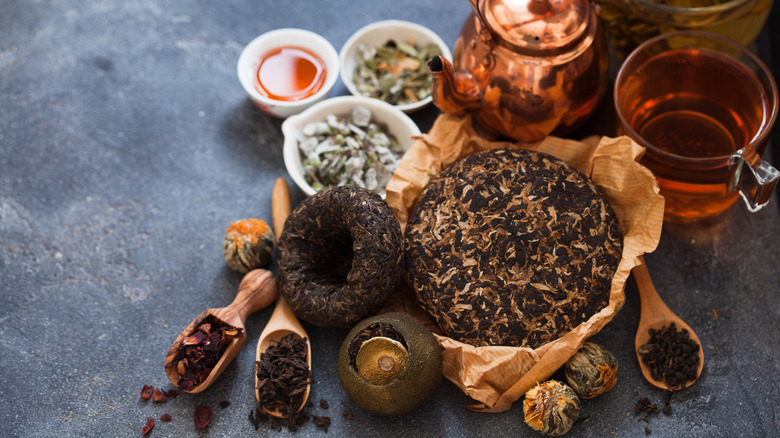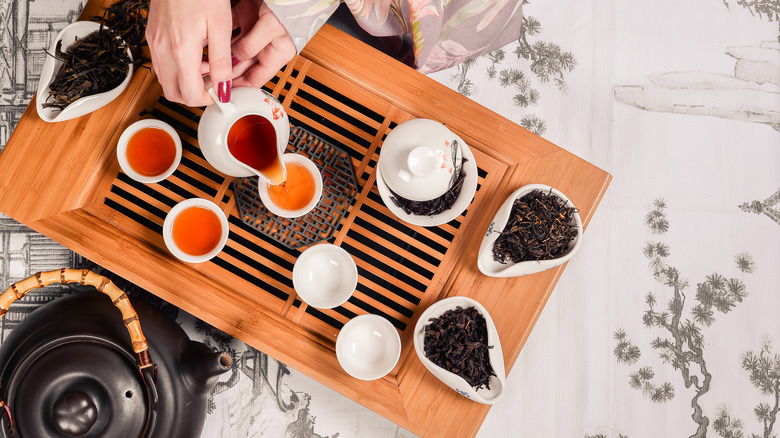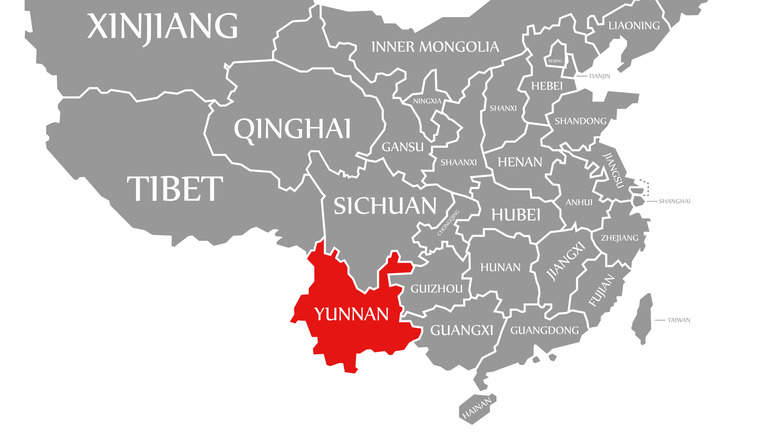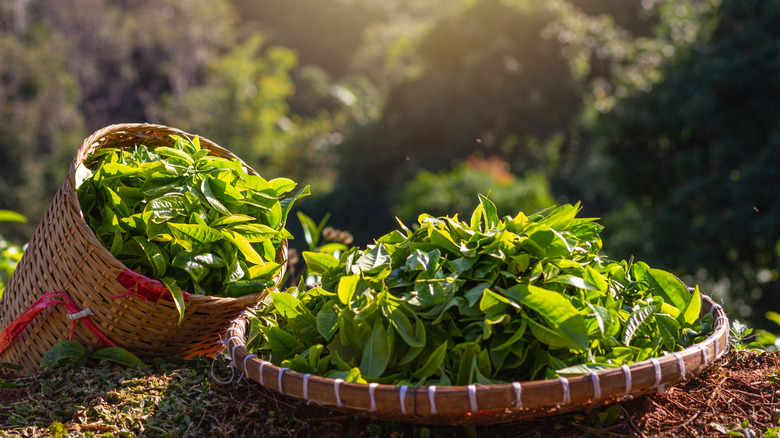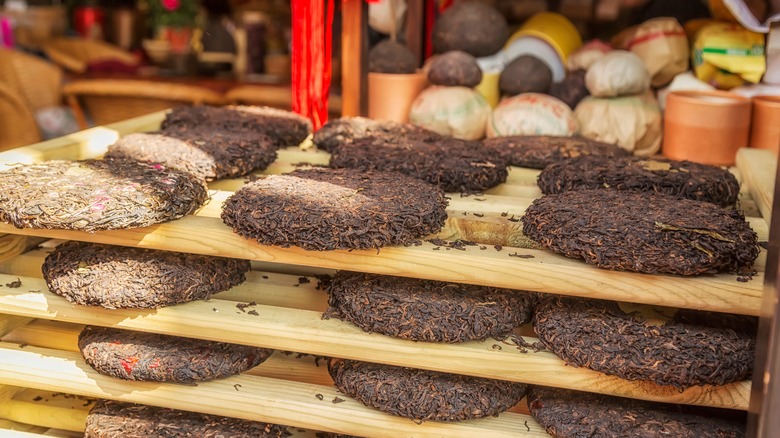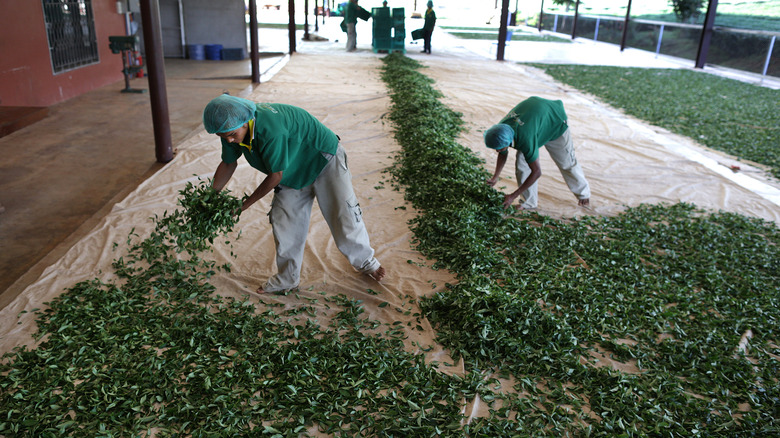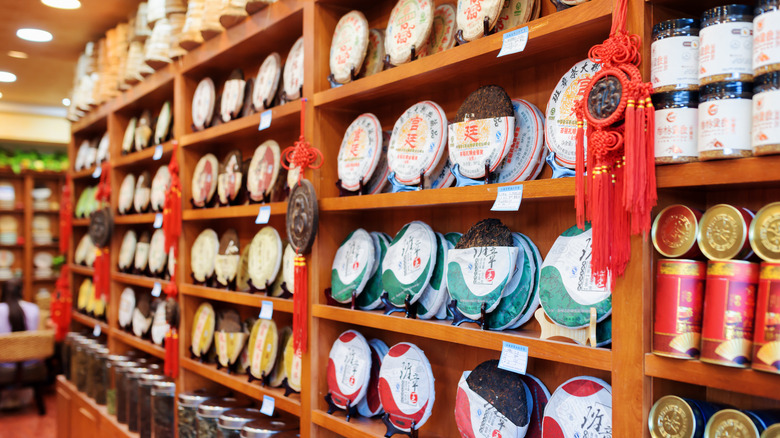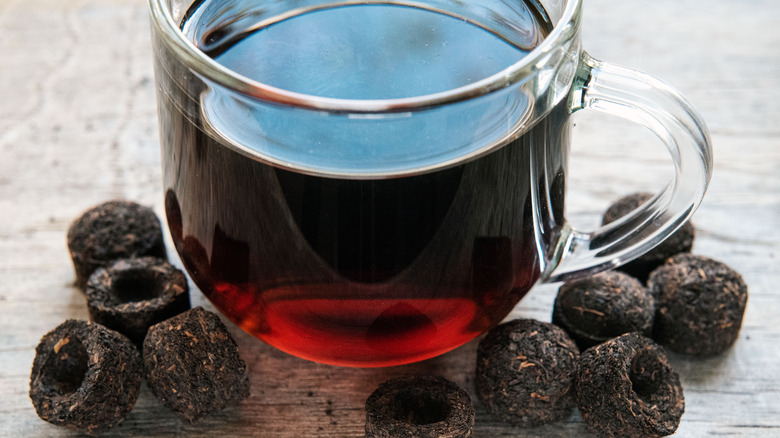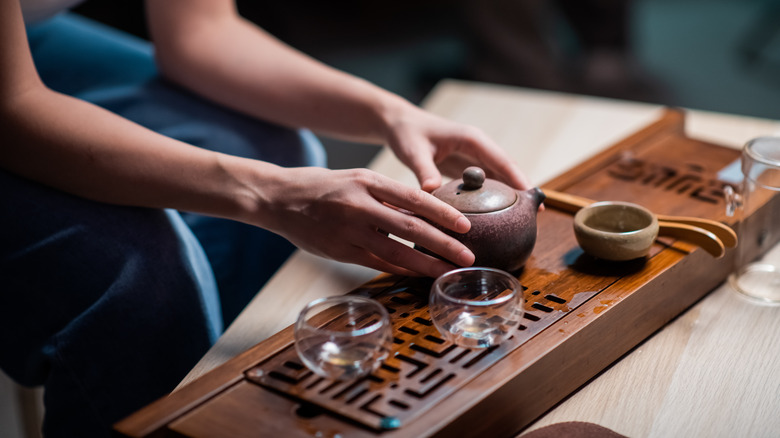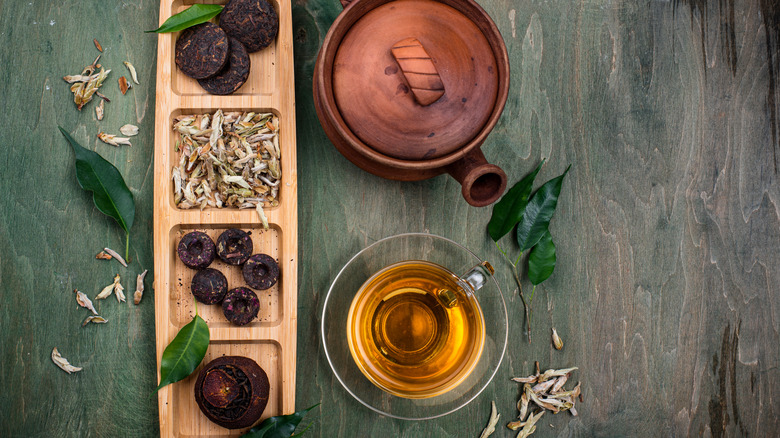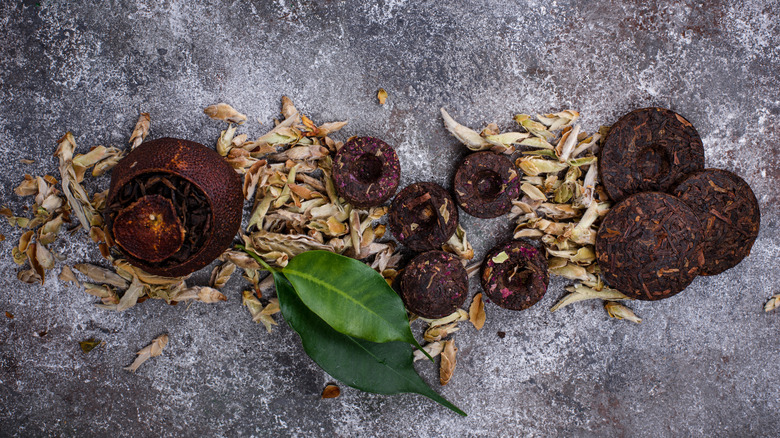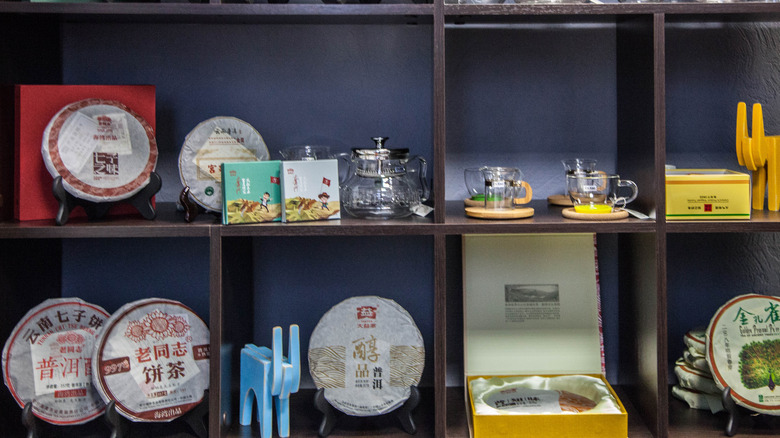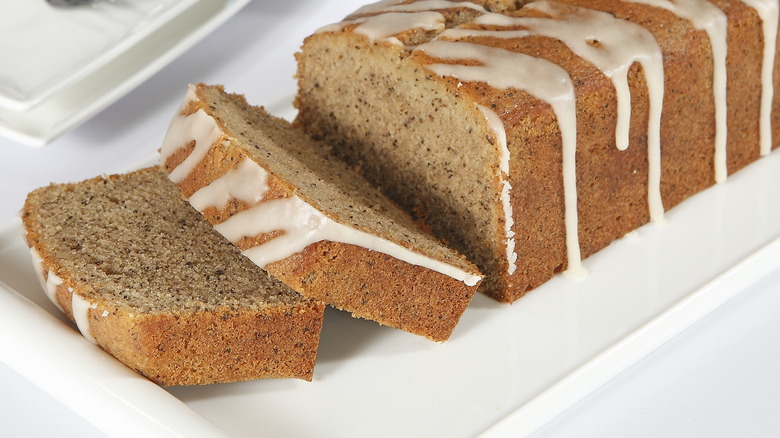Everything You Need To Know About Pu'er Tea
Pu'er, an ancient type of tea that is also spelled pu'erh, is world renowned for its flavor and cultural significance, especially in the region of China where it has been produced for centuries. On top of that, Healthline finds that this tea has some impressive health benefits such as killing cancer cells in studies and increasing liver health, making it delicious and medicinal. Pu'er also has an incredibly unique production process, which makes it an anomaly in the tea world and worthy of attention.
While there are countless varieties of tea around the world, few types of tea can compare to pu'er's unique flavor, complex history, and profound importance. With thousands of years of history, there is a lot to learn about this coveted tea and no better time to learn all about it. Come explore all that this magnificent, alluring tea has to offer you (and it's full of surprises).
Pu'er is a highly valued tea
Pu'er, also spelled puerh, is highly prized for its cultural significance, complex flavor, and long history. So, what is it? Pu'er is a type of tea, but not just any type of tea, it is one of the most expensive, highly valued, and technically complicated teas to make in the world. Originating from China, and now enjoyed all across the world, this famous tea has long been valued and prized for its complex flavor.
According to NPR, there are a number of parameters pu'er must pass in order to be called pu'er. Those of which include the location of where the tea leaves were grown, their processing method, and how they are fermented. Yes, fermented. Part of what gives pu'er its deep, intricate flavor is the long period of fermentation the leaves must go through before being prepared for sale and consumption. The fermentation period can range from anywhere between a couple of months to five decades, making pu'er a collectors item that brings connoisseurs flocking (via Mansa Tea). Due to its history, origin, and extreme cultural importance, pu'er is renowned as more than just a tea. It is an intricate part of Chinese culture, specifically in the region it originates from, Yunnan.
Pu'er is from Yunnan
Many teas originate from China, yet the specific mountains and regions that are responsible for the processing of pu'er are extremely culturally important and beautiful. Yunnan is a province in southwestern China that borders Tibet, Laos, Myanmar, Vietnam, the Zhuang Autonomous Region of Guangxi, and the other Chinese provinces of Sichuan and Guizhou (via Britannica). Needless to say, Yunnan is a huge mix of many cultures, and on top of that, it has many micro-climates.
However, it is only in the very south of Yunnan that the famous pu'er trees can grow. The three main pu'er tea-producing regions of Yunnan are Xishuangbanna, Pu'er, and Lincang, which, when combined, makeup 90–95% of the world's pu'er tea production (via CSPuer). Around these regions are areas known as The New 6 Great Tea Mounts and The Old 6 Great Tea Mounts, which produce the best pu'er in the world. Teawald describes the pu'er sourced from these mountains as "soft, gentle, and sweet" with some of the best pu'er hailing from the mountain Yiwu, referred to as the queen of pu'er.
Pu'er is made from tea leaves
You know that pu'er is made from tea leaves; however, what may surprise you is how many types of tea there truly are, and how much variation in final flavor, color, shelf life, and use, can be derived from the tea plants themselves. While most tea in the world actually comes from the same plant — camellia sinensis — it is thanks to the different processing methods that they taste so different.
Pu'er is no different; in fact, it is really the example. To make true pu'er, the largest leaves of wild or cultivated tea plants are gathered and processed. Sometimes specifically the buds are picked while other methods use both the buds and leaves, but in general, the larger leaves are preferred for pu'er (via Bana Tea Company). Pu'er is picked from the same camellia sinensis, but a specific variety, which partly explains this tea's unique flavor.
There are multiple grades of pu'er that refer to the tea leaf sizes used to make the tea, but large leaves are the most traditional. On the market today, Teewald explains that about 95% of the large leaf pu'er varieties available are gathered from wild plants.
Pu'er tea has an ancient history
For the Indigenous people of Yunnan, pu'er is an integral part of their lives, and they have been cultivating, drying, and consuming pu'er tea along the Lancang River for centuries (via Teewald). For thousands of years, pu'er has been produced in this region of the world, gathered from trees that are over a thousand years old. If you have ever seen pu'er, it may have been formed into a brick or disk.
This practice, which began with merchants during the Tang dynasty, made tea easier to transport (via Bana Tea Company). As pu'er ventured farther and farther from Yunnan, it had to travel through all weather conditions. According to the Bana Tea Company, this transformed the tea: It fermented, it aged, and eventually its flavor changed almost completely. No longer was the pu'er green and fresh, instead, the tea had turned dark in color and adopted a rich, full flavor
The process of making pu'er is complex
Once the pu'er leaves are picked they are immediately sun-dried to help rid them of excess moisture. This step can also be skipped depending on the tea processor. Artful Tea explains the next step is wok roasting the tea leaves in a process known as "killing the green," which prevents oxidization and takes about 15-30 minutes for each batch. This process rids the pu'er of almost, but not all, enzymatic activity, says Artful Tea, which better enables it to ferment and develop its unique flavor. This step is followed by hand rolling the leaves into small balls that are then left in the sun to dry before either being sold as loose-leaf tea or packed into bricks.
White2Tea explains the process of packing pu'er into bricks: The first step is moistening the leaves so that they will stick together and hold their shape; then the leaves are placed in a cloth bag and pressed into any shape, with the most common being bricks and disks. According to Mansa Tea, the bricks are then left to ferment, which is when the magic truly happens. During the fermentation period, pu'er develops its signature complexity of flavor, and this richness only deepens over time. The fermentation period varies, however, depending on the type of pu'er.
Evidently, making pu'er is incredibly intricate and moreover, varies greatly from producer to producer; therefore, we've only touched on the deeply complicated process.
The different types of pu'er
The types of pu'er can be roughly split into two categories, raw and ripe. Raw pu'er is also known as Maocha or Shengcha, more closely follows the above processing description than its counterpart, ripe pu'er, also known as Shou Cha (via Artfultea).
Today, maocha is sometimes used to only refer to pu'er, but Teahong explains that maocha actually can mean many types of tea such as oolong, black, or green teas. Therefore, it is important to differentiate which tea is being referred to when you say maocha. Furthermore, according to the Tea Guardian, maocha and shengcha are names for almost the same product with the subtle difference being in the perspective. Pu'er maocha refers to the tea at a processing point, while shengcha signals that it is ready for consumption. Shengcha can also be pressed into signature pu'er disks or bricks, and then aged for years before it is enjoyed.
Now for our last category: shou cha is a more modern way to make pu'er that uses an accelerated fermentation process that mimics traditional shengcha fermentation. Shou cha, also known as ripe pu'er, involves moistening the leaves and turning them periodically in a process called "wet piling," as per Mansatea. This technique encourages fermentation and speeds up the pu'er production process significantly. Unlike sheng cha, which can take decades to finish fermenting, shou cha can be ready in much less time, making it more affordable but less flavorful and coveted.
The taste of pu'er varies widely
The taste of pu'er tea has been described in many ways, from smooth to rich, and fruity. As with any product, the quality and taste of pu'er varies greatly depending on many factors and a person's personal preferences. Therefore, just like with any fine wine or other fermented food, pu'er can please some or deter others.
The tea, when steeped, takes on a dark brown, almost red color, which matches the dark leaves and deep flavor. Thanks to the long fermentation time and multiple drying stages, pu'er also has a very rich and sometimes even fruity flavor. This richness is even more profound the longer the pu'er is fermented. Artful tea also adds that pu'er is incredibly smooth and has none of the acidic tannins that some other teas have. Additionally, pu'er is often described as earthy or mushroomy, which can be explained by the fermentation process which brings a lot of umami flavor to the tea. As the tea steeps through each round of infusions, the flavor can transform even more. It starts out lighter, and with each subsequent infusion grows in flavor and depth, taking on more complexity and richness.
Pu'er can be prepared in multiple ways
Since shu cha and sheng cha pu'er teas are so different, it should come as no surprise that they are usually steeped differently. Additionally, there are many ways to steep tea. The key to making pu'er is tasting it every 30 seconds while steeping to know what you prefer. The longer pu'er steeps, the deeper its flavor becomes, as per The Teasource. When making pu'er, regardless of the method you choose, make sure to steep the tea in water that is just under boiling. This way you will make sure not to burn the leaves.
Teasenz says one of the steeping methods is called the grandpa method, which involves letting the leaves steep directly in your cup for about two to three minutes — then refill your cup when the tea becomes bitter. Another method, called gong fu or gong fu cha brewing, is the much more traditional method of steeping pu'er, and requires practice and a deep understanding of the tea. Gong fu begins with rinsing the leaves as a way to awaken them, then steeping in a special yixing teapot, starting with 10-second infusions.
According to Teawald, you can then use the same leaves for multiple infusions, sometimes up to as many as 20. If you do this, make sure to add five to 10 seconds of steeping time for each infusion, and note how the tea's flavor and color change with each new round.
The benefits of pu'er
Pu'er is more than just a uniquely delicious tea, it also boasts a handful of health benefits. First of all, pu'er is widely prized for its ability to ease digestion and settle an upset stomach. It also cleans the body of toxins and free radicals, as per Storehouse Tea. This makes pu'er a prized cancer prevention tea that is invaluable for its medicinal properties. But that is not all. According to Healthline, pu'er helps reduce cholesterol by preventing how much dietary fat can be absorbed in the bloodstream, and by decreasing overall fat accumulation.
Pu'er is also believed to help with weight loss through its ability to prevent fat accumulation and by helping the body burn stored fat. Taking into consideration that pu'er is a fermented tea, it also has the ability to introduce beneficial probiotics to the body, potentially helping with gut health and overall digestion.
The quality of pu'er depends on many variables
The first thing to consider when evaluating the quality of pu'er is the location of where the tea leaves were grown. Yunnan, specifically the very south of the province, produces the majority of the world's pu'er. Therefore, pu'er leaves grown elsewhere in the world will most likely not be as rich, floral, and layered as the teas from Yunnan. This can be attributed to a variety of factors such as a difference in elevation, temperature, and humidity, all of which can change the flavor of the tea leaves and therefore the tea (via CSPuerh).
Another important thing to consider is the age of the trees. In the pu'er world, the older the tree generally means the more desirable the tea, and, according to Teadrunk, trees specifically planted in the Ming and Qing Dynasty, which are anywhere from 200 to 600 years old, yeild the most desirable leaves.
In addition to tree age, the processing, storage conditions of the pu'er, and the harvesting time of the leaves all have a great effect on the quality and taste of the final tea. To help you know what quality your pu'er is, and to classify the flavor and desirability of pu'er, there are 10 distinct grades (via CSPuerh). While it is still recommended that each individual chooses their pu'er based off of personal preference, in general, the higher the grade, the higher quality pu'er.
The cost of pu'er
Pu'er is well known to be one of the most expensive teas in the world, but what does that really mean? As with anything, the price of pu'er has a range, and with improved efficiency in production through the creation of new processing methods, such as the process of making Shou cha, the price of pu'er has decreased. Nonetheless, traditionally and artisanally made pu'er is still, if not more, highly sought after as this drink becomes more and more famous.
The prices of pu'er can vary, but in general, tend to be astronomical, explains Jing Tea. To give some perspective, Jing Tea states that one cup of high-quality pu'er at a renowned Shanghai tea house can be tasted for $2,500 USD. While on the other hand, if you wanted to taste a lower quality tea, as opposed to one that has been fermenting for decades, at this shop, you can still expect to pay over $100. So can you guess how much a whole patty of this tea would cost? At this tea house, it is not uncommon to find them selling for anywhere from $25,000–$50,000.
Other uses of pu'er
Pu'er, with its health benefits, tantalizing flavor, and rich history, is a tea of many uses. Not surprisingly, it is also incredibly multi-purpose and can be used for many things other than just drinking. According to Tea Vivre, pu'er can be used to wash your clothes, shine your furniture, or even freshen your breath. Also, thanks to its unique color that is a mix between red and brown, pu'er can also be used as a food coloring in baking or cooking.
Pu'er, like many other teas, can also bring a delightful layer of flavor and depth to your culinary endeavors. Next time you are looking to use your pu'er in something other than plain tea, try making a tea infused cocktail, and enjoy how the fruity, rich flavor of the pu'er balances well with other garnishes. You can also try substituting pu'er in any earl grey dessert recipes. This will transform your dessert in both flavor and color, brining an unparalleled richness to your desserts.
